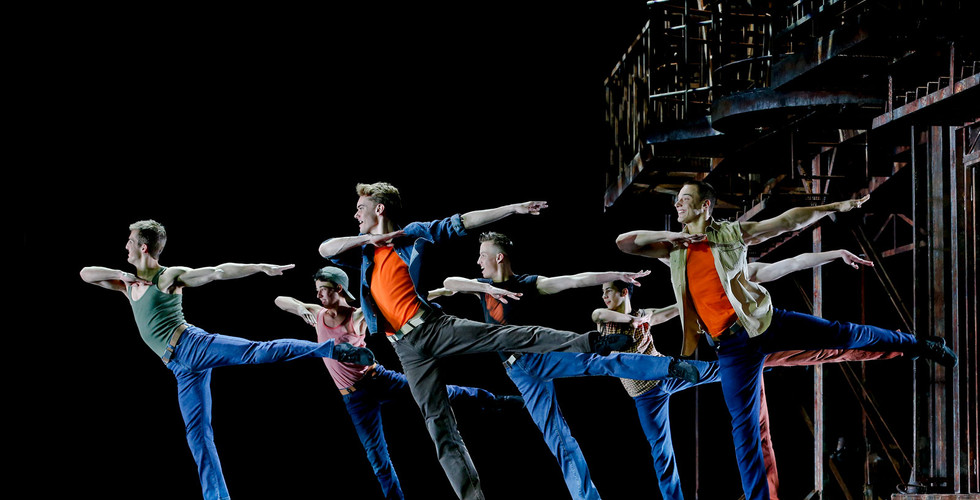Review: WEST SIDE STORY at the Festival Theatre
- Theatre Travels

- Nov 30, 2019
- 4 min read
By Lisa Lanzi
The New York premiere of West Side Story was on September 26, 1957 with the dream team of choreographer/director Jerome Robbins, composer Leonard Bernstein, book by Arthur Laurents and lyrics by a young Stephen Sondheim. Although not an immediate hit in America, in 1958 it took London’s West End by storm, returned triumphantly to Broadway in 1960 and the show’s legendary status was cemented. Martin Charnin, an original Jet, says “You know how there’s Mount Everest and then there are mountains? As far as I’m concerned, there’s West Side Story and then there are musicals.”
Most people know the story, set in the 1950s, concerns rival New York gangs (the Puerto Rican American Sharks and white American Jets) and that it plays out as a tragic Romeo and Juliet romance. Sadly, this sense of visceral and tribal conflict still resonates strongly given the many appalling conflicts throughout our world. Despite its mid-20th Century setting and genesis, West Side Story as a piece of musical theatre still ignites and doesn’t seem to date, such is the magic and power of the music and choreography.
In this production it is the dancing that shines with tight ensemble work and a talented, highly trained young cast who move with style, intensity and some phenomenal elevation. Joey McKneely is responsible for both direction and re-creating the stunning Robbins choreography and has done so across the world, as originally coached by Robbins himself. There is a pure synergy between the movement and Bernstein’s symphonic score and complex rhythms as the dancers command the stage. With influences from classical ballet, jazz, social and culturally specific dance this choreography has attained icon status in the world of musicals. All the dance sequences were excellent but the dream sequence Ballet and the simmering opening Prologue were standouts.
The genius set and stage design by Paul Gallis also steals the limelight in this iteration of West Side Story. Representing Manhattan’s Upper West Side 1950s tenement housing there are towering metal scaffolds with working fire escape ladder and elevated areas to allow for some balcony action. The set also rolls seamlessly to and fro across the stage to depict various locations with some impressive hydraulics in action no doubt. In addition to the remarkable on stage construction, huge and slightly grainy black and white projections of old New York appear from time to time on the rear cyclorama adding atmosphere and context. Costume designer Renate Schmitzer has contributed colour-coded costuming with bold brights for the Sharks and more muted denim, khaki and white for the Jets. This detail gives a slight contemporary punch to the look of the production but still works well to designate cultural differences. The women’s clothing is similarly coloured to place them firmly in one or the other ethnic group and particularly for “Dance at the Gym” and “America”, suitably flamboyant.
In a sense, the casting of this production reflects the original 1957 process - relatively unknown talent being given opportunities to kick-start their professional stage career. The pivotal and vocally demanding role of Maria is beautifully portrayed by Sophie Salvesani in her professional debut. She imbues the character with an alluring mix of teenage innocence, womanly intuition, tenderness and wonder. Salvesani’s classically trained voice is strong and crystal clear with some delicate vibrato and soaring high notes. Her striking Tony is brought to life by Todd Jacobsson who shines in lighter acting moments where he revels in his new found love. This young man’s tenor voice is quite good but does not deliver the strength required by this role. There were moments where Jacobsson’s range seemed limited for the vocal demands, especially in the lower registers. Also, the duets with Salvesani were not as powerful given the discrepancy between classical and Broadway voices and the chemistry was a little lacking.
The fierce role of Anita is delivered with appropriate sass and excellent accent by Chloé Zuel and as an ensemble, the supporting cast are generally outstanding. The American and Puerto Rican accents were also mostly excellent with a few glaring moments of inconsistency. Among the older actors on stage Ritchie Singer as Doc gives a remarkable performance with utter truthfulness and presence. The character’s words in Act Two truly encapsulate the tragedy of the conflict. Paul Dawber (Lt. Schrank), Berynn Schwerdt (Officer Krupke) and Paul Hanlon (Glad Hand) also contribute much to the action with assured performances and crystal clear dialogue.
I spoke with other reviewers and some staff during interval and post show to get some context for my next remarks. My plus one and I were both alarmed by the sound quality from the start of the show in that the voices, both sung and spoken, were mostly very quiet in the mix. I know that our beloved Festival Theatre has a few ‘dead’ spots but given that that most of the older actors could be heard very clearly in their speaking roles I am left wondering why some dialogue and lyrics from the younger cast members were so inaudible. It was not consistently so, but regular enough to be annoying and seemed to be a combination of diction and technical issues.
This is overall an EXCELLENT production, deserving of an audience and still as thrilling as the first time I saw it. If you love musicals, or inexplicably (!) have never seen West Side Story - GO!
Image Credit: Jeff Busby
All opinions and thoughts expressed within reviews on Theatre Travels are those of the writer and not of the company at large.




















